|
|
|
Sort Order |
|
|
|
Items / Page
|
|
|
|
|
|
|
| Srl | Item |
| 1 |
ID:
134068
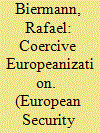

|
|
|
|
|
| Publication |
2014.
|
| Summary/Abstract |
Secessionism is still the predominant conflict type in Europe. Even though the European Union (EU) extended the enlargement perspective to the Balkans 15 years ago, secessionist ambition remains pervasive, especially in Bosnia, Kosovo, Macedonia and Serbia. How does secessionism affect Europeanization and how does Europeanization affect secessionism? It is argued here that in cases of unattained statehood domestic power struggles among deeply divided elites over status and territorial control undermine the consensus needed for Europeanization. In cases of attained de facto statehood the conflict focuses on recognition, which likewise polarizes societies and marginalizes reform. In such high-resistance scenarios, where the inclusionary EU norms clash with the exclusionary norms of the secessionists, the EU vigorously works to marginalize the secessionists by relying mainly on denial, punishment and imposition. Still, the EU's leverage is often insufficient in moving the conflicting parties towards within-state solutions and reform. A study of Bosnia's transformation since Dayton reveals, however, that the EU's leverage varies over time and that the EU at times itself inadvertently fans secessionism.
|
|
|
|
|
|
|
|
|
|
|
|
|
|
|
|
| 2 |
ID:
140786
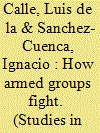

|
|
|
|
|
| Summary/Abstract |
This article analyzes the choice of tactics by armed groups. We claim this choice is largely determined by the capacity of the rebel groups to control territory. Groups that are not able to liberate territory remain underground and have to rely mainly on bombings. Groups with territorial control engage in guerrilla-like attacks in which there is a physical encounter with the enemy. This conjecture is tested and largely confirmed at three levels: a cross-sectional analysis of the distribution of tactics in 122 armed groups, using compositional data analysis; a geographical analysis of the distribution of tactics in the largest cities as opposed to the rest of the country; and a case study of Hezbollah.
|
|
|
|
|
|
|
|
|
|
|
|
|
|
|
|
| 3 |
ID:
182542
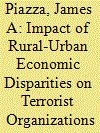

|
|
|
|
|
| Summary/Abstract |
This study investigates the influence of rural-urban economic disparities on the survival and tactical choices of resident terrorist groups. These disparities inflame social and ethnic group grievances and erode the state’s capacity to police its rural hinterlands, thereby motivating support for terrorists and providing resident terrorist groups with the ability to attack with impunity. Based on the Extended Data on Terrorist Groups (EDTG), survival analysis shows that rural-urban disparities foster terrorist group survival. Other empirical methods – negative binomial regressions and competing risk analysis – indicate how rural-urban disparities and other controls affect resident terrorist groups’ campaigns and prospects. With mediation tests, rural-urban inequalities are shown to benefit terrorist groups by increasing social group grievances and by limiting host state’s control over territory.
|
|
|
|
|
|
|
|
|
|
|
|
|
|
|
|
| 4 |
ID:
132217
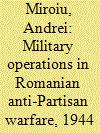

|
|
|
|
|
| Publication |
2014.
|
| Summary/Abstract |
Romanian anti-communist armed resistance has received relatively little attention outside the country, despite its resemblance to other small, diffused, headless insurgencies being fought in the first decades of the twenty-first century. This article deals with military operations mounted against the partisans, with a special focus on tactics such as cordoning, checkpoints, patrols, sweeps, ambushes, and informed strikes. Based mostly on primary sources, it highlights success and failure against determined and elusive guerrillas.
|
|
|
|
|
|
|
|
|
|
|
|
|
|
|
|
| 5 |
ID:
133592
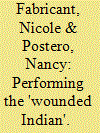

|
|
|
|
|
| Publication |
2014.
|
| Summary/Abstract |
This article examines Right-wing political performances in the Bolivian Eastern lowlands where regional elites claim to be living under the authoritarian dictatorship of Left-leaning President Evo Morales. We analyse how regional elites advocate for political autonomy through embodied and spectacular performances linked to discourses of indigeneity, human rights and democracy. Right-wing leaders try to legitimise their claims for justice and territorial control by strategically aligning themselves with lowland 'Indians' - who are equally wounded by Morales's plan to run a massive highway though their communities and territories. Through theatrical exhibits in the plaza and a spectacular assembly spotlighting an indigenous representative as an emblematic hero of TIPNIS, regional elites perform a shared history of marginalisation, while simultaneously presenting themselves as 'saviors'. We argue, however, that there is a dark side to these performances, as they elide long histories of racialised labour and economic injustice in the region.
|
|
|
|
|
|
|
|
|
|
|
|
|
|
|
|
| 6 |
ID:
155185


|
|
|
|
|
| Summary/Abstract |
I study civilians’ cooperation with an armed group in an irregular war. In the model, civilians differ in their valuation of siding with the armed group and make cooperation decisions without knowing others’ motivations or cooperation choices. I find that a superior military force is not sufficient to bring high cooperation and that full cooperation can only be attained if military power is complemented by expectations of punishment for helping the enemy. The model challenges the idea that random violence aimed at punishing enemy cooperators is used when selectivity is difficult to implement, and it shows that indiscriminate reprisals induce lower levels of cooperation, even when enemy cooperators are less likely to be punished with selective methods. Finally, I find that communities that have a highly centralized process of decision making are expected to give their support to only one group of combatants and to be exposed to less violence.
|
|
|
|
|
|
|
|
|
|
|
|
|
|
|
|
| 7 |
ID:
113947


|
|
|
|
|
| Publication |
2012.
|
| Summary/Abstract |
The large-n literature on political violence has paid little attention to the distinction between insurgencies that control territory and those that do not. Territorial control has consequences for the lethality of the group, its pattern of recruitment and bargaining power. The main determinant of territorial control, we argue, is state capacity: while territorial insurgencies are more frequent in poor countries, nonterritorial ones tend to occur in countries with intermediate levels of development (rich countries are free of internal violence). The authors show that the relationship between development and nonterritorial violence is a concave one, using a panel for the period 1970-1997 that combines existing data sets on civil wars and the Global Terrorism Database 1. The authors also find that nonterritorial violence is more likely in democratic, old states. Population, rough terrain, and inequality have a similar impact on both types of conflict. The authors discuss to what extent territorial conflicts correspond to civil wars and nonterritorial ones to terrorism.
|
|
|
|
|
|
|
|
|
|
|
|
|
|
|
|
| 8 |
ID:
129597
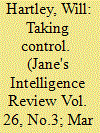

|
|
|
| 9 |
ID:
140261
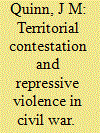

|
|
|
|
|
| Summary/Abstract |
This study models the structural sources of variation in the use of selective (discriminate) repression within 89 civil wars fought between 1981 and 2005. The severity of repressive violence is modeled as a function of the amount of territory being contested by the insurgents. This idea is operationalized using measures of the location, size, and density of insurgency violence. The analysis finds evidence that the repressive behavior of both governments and rebel groups is linked to conflict geography. Governments violate physical integrity rights more frequently and kill more civilians the greater the overall amount of territory under contestation. Rebels kill more civilians in highly dispersed insurgencies that lack a clear epicenter.
|
|
|
|
|
|
|
|
|
|
|
|
|
|
|
|
| 10 |
ID:
176040
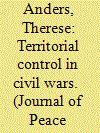

|
|
|
|
|
| Summary/Abstract |
Territorial control is a central variable for civil war research – yet, we lack sufficiently detailed data to capture subnational dynamics and offer cross-country coverage. This article advances a new measurement strategy for territorial control in asymmetric civil wars. Territorial control is conceptualized as an unobserved latent variable that can be estimated via observed variation in rebel tactics. The strategy builds on a theoretical model of rebel tactics, by which rebels use terrorism less when they control a given area – preferring conventional tactics, which require higher levels of territorial control. The latent variable, territorial control, is estimated via a Hidden Markov Model (HMM). As an observable indicator for rebel tactics, I leverage geo-coded event data and a function of the relative frequency of terrorist attacks and conventional war acts, weighted by time and distance. The model yields estimates of territorial control for asymmetric civil wars at a resolution of 0.25 decimal degree minimum diameter hexagonal grid cells. Validation of estimates for the Colombian and Nigerian civil wars suggests HMMs as a fruitful avenue to estimate spatiotemporal variation in territorial control.
|
|
|
|
|
|
|
|
|
|
|
|
|
|
|
|
| 11 |
ID:
126022
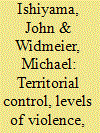

|
|
|
|
|
| Publication |
2013.
|
| Summary/Abstract |
This paper explores debates about electoral patterns in post-civil war societies. In particular, we examine whether the ability of rebels to capture and control territory and the level of violence at the local level explains the electoral performance of former rebel political parties, focusing on the Islamic Renaissance Party of Tajikstan (IRPT) and the Communist Party of Nepal (Maoist) (CPN (M)). Using data from the 2000 legislative election in Tajikistan and the 2008 Nepalese Constituent Assembly election, this paper finds that rebel control over districts did explain rebel party's electoral performance in Nepal. However, rebel control of districts in Tajikistan during the civil war did not predict the electoral performance in the first post-conflict election in that country. This is largely due to the disconnect between the IRPT and the constituencies that had supported it during the civil war, and because the level of control that the party exerted was far less than that of the CPN (M).
|
|
|
|
|
|
|
|
|
|
|
|
|
|
|
|
| 12 |
ID:
107994
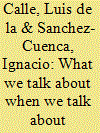

|
|
|
|
|
| Publication |
2011.
|
| Summary/Abstract |
There is no consensus in the literature about the nature of terrorism. The authors' main claim is that this is ultimately the result of the coexistence of two senses of the term, the action and the actor sense, which are not fully congruent. Rather than trying to advocate a specific conceptualization, the authors provide in this article a map of the different ways in which scholars talk about terrorism. They identify first the set of terrorist actions and the set of terrorist actors. Terrorist tactics are a variety of the power to hurt, based on the lack of military power. Terrorist groups are underground ones with no territorial control. When the two criteria meet, the core of terrorism exists: coercive violence perpetrated by underground groups. The ambiguity that surrounds terrorism is caused by two other possibilities: actors with some measure of territorial control adopting coercive tactics and underground actors adopting military tactics. Although it is not possible to remove this ambiguity in empirical research, scholars can at least identify it and analyze it. The authors illustrate the two senses of terrorism and their interaction by using the most comprehensive dataset on terrorist incidents, the Global Terrorism Database (GTD).
|
|
|
|
|
|
|
|
|
|
|
|
|
|
|
|
|
|
|
|
|